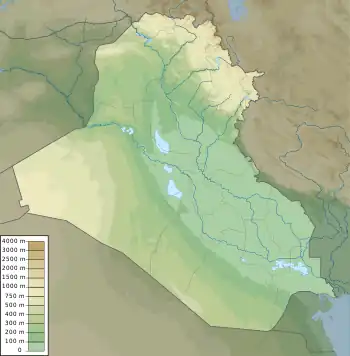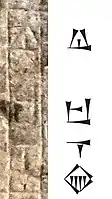Pashime
Pashime, also Bashime (𒁀𒋛𒈨𒆠 ba-si-meKI), was an ancient region of southern Mesopotamia. It has recently been identified with Tell Abu Sheeja, Iraq, about 7 km from Iraq's border with Iran.[1][2] Pashime corresponded to an area of interaction between Mesopotamia and Elam. Its patron god was Shuda.[2] The city of Pashime was previously thought to be located on the Persian Gulf.[3][4]
 Pashime Shown within Iraq | |
| Alternative name | Tell Abu Sheeja |
|---|---|
| Location | Maysan Governorate, Iraq |
| Region | Mesopotamia |
| Coordinates | 32°23′45″N 47°8′52″E |
| Type | Settlement |
| History | |
| Founded | 3rd millennium BCE |
| Site notes | |
| Excavation dates | 2007 |
| Archaeologists | A. Mohammad, H.A. Hamza |
A stele was discovered in Tell Abu Sheeja with the name of a Governor Ilšu-rabi, who has the same name as Ilšu-rabi the Governor of Pashime in the Manishtushu Obelisk inscription.[5][2] The inscription on the stele reads:
"For the God Shuda, Ilsu-rabi of Pashime, the soldier, brought in this statue. May the one who erases the name (on this inscription) not find an heir; may he not acquire a name (for himself)

 Inscribed door-socket from the Temple of Šuda at Tell Abu Sheeja, Iraq. Ur III period, 21 century BCE. Iraq Museum.[2]
Inscribed door-socket from the Temple of Šuda at Tell Abu Sheeja, Iraq. Ur III period, 21 century BCE. Iraq Museum.[2] The name of Pashime (𒁀𒋛𒈨𒆠 ba-si-meKI) on the stele of Ilšu-rabi
The name of Pashime (𒁀𒋛𒈨𒆠 ba-si-meKI) on the stele of Ilšu-rabi
References
- Crawford, Harriet (2013). The Sumerian World. Routledge. p. 162. ISBN 978-1-136-21912-2.
- "Tell Abu Sheeja/ Ancient Pashime" (PDF).
{{cite journal}}: Cite journal requires|journal=(help) - Hussein, A. M.; Hamza, H. A.; Thaher, A. K.; Kadhum, S. J.; Hashem, M.; Taha, H. M.; Altaweel, M. R.; Studevent-Hickman, B. (2010). "Tell Abu Sheeja/Ancient Pašime: Report on the First Season of Excavations, 2007". Akkadica. 131 (1): 47–103.
- Mohammad, A., Hamza, H.A., Kadhum, A., "The Excavations of Tell Abu Sheeja, The 1st Season 2007", Sumer 53, pp. 61-110, ('05/'06) (arabic)
- Eppihimer, Melissa (2019). Exemplars of Kingship: Art, Tradition, and the Legacy of the Akkadians. Oxford University Press. p. 222. ISBN 978-0-19-090301-5.
- Eppihimer, Melissa (2019). Exemplars of Kingship: Art, Tradition, and the Legacy of the Akkadians. Oxford University Press. p. 222, note 26. ISBN 978-0-19-090301-5.